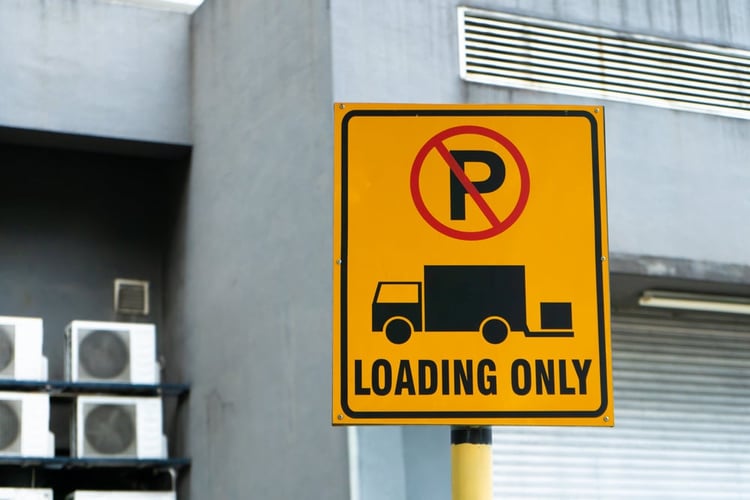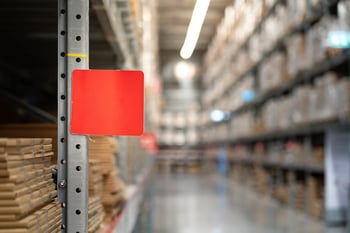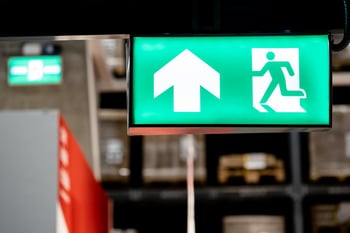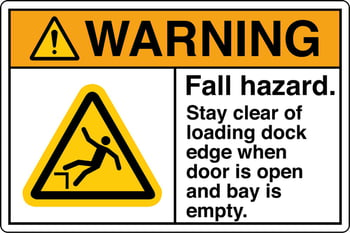
The high-demand, fast-paced warehouse environment can be burdened by inefficiencies and safety hazards that impact operations. Many businesses in this industry fail to recognize that some simple strategies can improve operations and create a safer and more attractive workplace for employees. Here’s why warehouse signage is so important and what types of signage your business should include.
Why is Warehouse Signage Important?
Having the proper labels, markings, and signs in your warehouse offers significant benefits to your business. Here are some of the top advantages of developing an excellent warehouse signage policy.
1. Reduces Workplace Accidents
There is a strong correlation between proper workplace signage and accidents. By developing a program for safety signage in your warehouse with consistent and uniform messaging, your business can significantly reduce its accident rates. This will also impact the rates of product and equipment damage.
2. Increases Warehouse Efficiency
 Consistent and clear communication through signage will increase your warehouse employees’ efficiency and productivity. Endless mistakes can be avoided in inventory storage, picking, packing, and shipping through the use of signs and labels. When your workers are aware of any existing hazards and have the information they need to do their jobs, they’ll perform with greater efficiency.
Consistent and clear communication through signage will increase your warehouse employees’ efficiency and productivity. Endless mistakes can be avoided in inventory storage, picking, packing, and shipping through the use of signs and labels. When your workers are aware of any existing hazards and have the information they need to do their jobs, they’ll perform with greater efficiency.
3. Promotes a Safety Culture
Your warehouse’s safety culture is not only essential to reduce accidents; it’s also important to attract and retain quality employees and get beneficial insurance rates. Proper signage is one of the foundations of creating a strong safety culture in your warehouse.
4. Enhances Supply Chain Efficiency
Beyond individual employees, warehouse labels and signs can improve efficiency throughout the supply chain. First, when you use RFID tags and share data about product movements, this enhances visibility throughout the supply chain. Second, improving your efficiency due to signage and labels will have ripple effects beyond your warehouse.
5. Protects from Legal Action
If someone gets injured in your warehouse, you must be able to show that you did your part to provide a safe work environment. Taking proactive steps to post signs showing clear pathways and warning of any hazards can protect your business from potential legal action.
6. Ensures Efficient Inventory Management
Signs and labels throughout the warehouse can create a more efficient inventory management system. Without them, there is a high risk of items being stored in the wrong place or delays in fulfillment as workers are unable to locate stored items. Signs and labels make this process more seamless, improving both the employee and customer experience.
7. Eliminates Processing Errors
By using warehouse rack labels and signage, you can eliminate errors related to record-keeping. For example, labels with barcodes or RFID tags can speed up the process of recording the movement of items throughout the warehouse. These labels also eliminate the need for manual data entry, which reduces errors.
8. Adheres to Regulatory Standards
Warehouses must conform to various regulatory standards when it comes to signage. Specifically, the American National Standards Institute (ANSI) and the Occupational Health and Safety Administration (OSHA) have combined standards that apply to warehouses.
Different Types of Warehouse Signage to Include
Proper warehouse signage is not just about aesthetics. It improves safety, compliance, and efficiency. Assess your signage to determine if you need any additions or updates. Here are the different types of warehouse signage you should have in your facility.
Safety
 Few signs are more important than your warehouse safety signs. These are the ones required by OSHA and even some state or local fire codes. They alert anyone in your warehouse of the business’s safety policies and procedures. They also warn of any known or potential hazards and point to the location of items like fire extinguishers and first aid kits.
Few signs are more important than your warehouse safety signs. These are the ones required by OSHA and even some state or local fire codes. They alert anyone in your warehouse of the business’s safety policies and procedures. They also warn of any known or potential hazards and point to the location of items like fire extinguishers and first aid kits.
Exit/Egress
Exit signs help people in your facility find their way out if there is a dangerous situation or a power outage. These are similar to other safety signs. However, exit signs must be illuminated to ensure anyone can find the exits, even in the dark.
Dock Doors
Warehouse operators and delivery drivers need to know where they are going at all times to improve efficiency and reduce confusion that could lead to errors and accidents. Signage attached to dock doors is vital. Since it is often outside, it should be reflective, large, and weather-resistant.
Row/Aisle
Row and aisle signs are easy-to-read signage throughout the warehouse that tells workers where they are. They should be bright and readable from a distance as well as located at all row or aisle entry and exit points.
Hanging
Employees and contract workers need as much assistance as possible to boost productivity and efficiency. Hanging signs throughout the warehouse are installed from the ceiling and can come in many sizes and shapes. They can include barcodes or RFID tags, which can be scanned from a distance to identify the correct storage area for items.
Consider OSHA Requirements With Warehouse Signage
When you create safety and caution signs for your warehouse, you’ll want to refer to OSHA guidelines. These requirements apply to signs giving safety instructions or warning workers about potential or known hazards. They don’t apply to labeling. Some of the requirements include:
1. Sign Format
According to OSHA recommendations, the “trigger word” for information signs should be at the top, and there must be an ANSI-approved hazard symbol at the lower left and middle of the sign.
2. Sign Headers
 OSHA guidelines state that the “trigger word” for the sign be in capitalized or block letters that create a contrast with the sign’s background. For most signs, black is the standard font color for the header.
OSHA guidelines state that the “trigger word” for the sign be in capitalized or block letters that create a contrast with the sign’s background. For most signs, black is the standard font color for the header.
3. Sign Font
OSHA recommends that safety signs use a san-serif font because it is easily readable from a distance. Examples include Verdana, Ariel, and Helvetica.
4. Sign Materials
OSHA guidelines state that warehouse safety signs be made from durable material that is simple to mount and will stand up to various environmental conditions. They should also have rounded corners.
5. Sign Visibility
Warehouse safety signage should be large enough that it can be easily read from the furthest reasonable distance. For example, from 40 feet away, the text on the sign would need to be 1.6 inches in height.
While some types of warehouse signage will be necessary for regulatory compliance, others are recommended to boost efficiency. As you work through these issues, make sure you thoroughly assess every area of your warehouse to determine where safety issues and bottlenecks might occur. These efforts will pay off as you create a more efficient, orderly, and safer warehouse.












